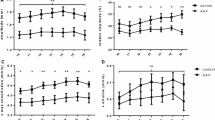Abstract.
Background
Although many previous studies reported abnormalities of autonomic function in patients with panic disorder (PD), almost all targets in those studies primarily focused on cardiovascular autonomic functions. In the present study, we determined whether PD patients exhibited abnormalities in the pupillary autonomic nervous system (ANS).
Methods
Before and after audiovisual stimulation (AS), which induced mental stress through exposure to video images of high stress experiences, such as driving motor vehicles, the pupillary light reflex (PLR) was measured by infrared pupillometer in 13 remitted PD patients and twenty age– and gender–matched normal controls (NC).
Results
Before and after AS, there were no significant differences in initial pupillary diameters in dark conditions (D1), pupillary diameters at maximum constriction (D2) or constriction ratios (CR: (D1-D2)/D1) between PD and NC subjects. However, the CR ratio (CR before/CR after) was significantly higher in the PD group than in the NC.
Conclusions
These findings suggest that even remitted PD patients may have a dysfunctional PLR regulation with experimental stressors such as AS.
Similar content being viewed by others
References
American Psychiatric Association (1994) Diagnostic and statistical manual of mental disorders, 4th ed. APA, Washington DC
Bakes A, Bradshaw CM, Szabadi E (1990) Attenuation of the pupillary light reflex in anxious patients. Br J Clin Pharmacol 30:377–381
Bitsios P, Szabadi E, Bradshaw CM (1996) The inhibition of the pupillary light reflex by the threat of an electronic shock: a potential laboratory model of human anxiety. J Psychopharmacol 10:279–287
Bitsios P, Szabadi E, Bradshaw CM (2002) Relationship of the ’fear-inhibited light reflex’ to the level of state/trait anxiety in healthy subjects. Int J Psychophysiol 43:177–184
Gorman J, Shear K, Cowley D, Cross CD, March J, Roth W, Shehi M (2000) Practice guideline for the treatment of patients with panic disorder. In: American Psychiatric Association (ed) Practice Guidelines for the Treatment of Psychiatric Disorders, APA, Washington DC, pp 563–625
Hasegawa A, Ishikawa T (1989) Age changes in pupillary light reflex: a demonstration by means of a pupillometer. Acta Soc Ophthalmol Jpn 93:955–961
Jeejeebhoy FM, Dorian P, Newman DM (2000) Panic disorder and the heart: a cardiology perspective. J Psychosom Res 48:393–403
Kojima M, Shioiri T, Hosoki T, Sakai M, Bando T, Someya T (2002) Blink rate variability in patients with panic disorder: new trial using audiovisual stimulation. Psychiatry Clin Neurosci 56:545–549
LeDoux JE, Iwata J, Cicchetti P, Reis DJ (1988) Different projections of the central amygdaloid nucleus mediate autonomic and behavioral correlates of conditioned fear. J Neurosci 8:2517–2529
Loewenfild IE (1993) The pupil. Iowa State University Press/Ames Wayne State University Press, Detroit
Margraf J,Taylor B, Ehlers A, Roth WT, Agras WS (1987) Panic attacks in the natural environment. J Nerv Ment Dis 175:558–565
Nagai M, Wada M, Sunaga N (2002) Trait anxiety affects the pupillary light reflex in college students. Neurosci Lett 328:68–70
Sheehan DV (1986) The Anxiety Disease. Rev. edn. Bantam, New York
Shioiri T, Murashita J, Kato T, Takahashi S (1996) Characteristic clinical features and clinical course in 270 Japanese outpatients with panic disorder. J Anxiety Dis 10:163–172
Shirakawa S, Ishikawa S, Rea WJ, Johnson AR (1991) Evaluation of the autonomic nervous system response by pupillographical study in the chemically sensitive patients. Environmental Med 8:121–127
Smith SA (1992) Pupil function: tests and disorders. In: Bannister R, Mathias CJ (eds) Autonomic failure. Oxford University Press, Oxford, pp 393–412
Yoshitomi T, Matsui T, Tanakadate A, Ishikawa S (1999) Comparison of threshold visual perimetry and objective pupil perimetry in clinical patients. J Neuroophthalmol 19:89–99
Author information
Authors and Affiliations
Corresponding author
Rights and permissions
About this article
Cite this article
Kojima, M., Shioiri, T., Hosoki, T. et al. Pupillary light reflex in panic disorder. European Archives of Psychiatry and Clinical Neurosciences 254, 242–244 (2004). https://doi.org/10.1007/s00406-004-0487-0
Received:
Accepted:
Issue Date:
DOI: https://doi.org/10.1007/s00406-004-0487-0




